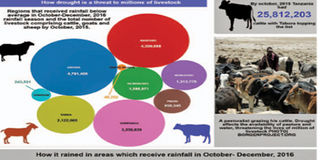Alarm as 21m livestock face starvation

What you need to know:
- A new assessment report by the Tanzania Meteorological Agency (TMA) on climate outlook for the short rain season obtained by The Citizen shows that Kilimanjaro, Arusha, Manyara, Coast, Tanga, Morogoro, Dar es Salaam and Shinyanga regions and Zanzibar received below average rainfall, a situation is certain to adversely affect agriculture and livestock.
Dar es Salaam. As the drought scare continues in several parts of the country, the meteorological agency has revealed areas that received below average rainfall between October and December, further raising concern with regard to the survival of over 21 million livestock due to shortage of pasture and water.
A new assessment report by the Tanzania Meteorological Agency (TMA) on climate outlook for the short rain season obtained by The Citizen shows that Kilimanjaro, Arusha, Manyara, Coast, Tanga, Morogoro, Dar es Salaam and Shinyanga regions and Zanzibar received below average rainfall, a situation is certain to adversely affect agriculture and livestock.
In total, the regions has a population of 21.42 million livestock, according to the 2014/15 Annual Agricultural Sample Survey (AASS) report. The data was for up to October 2015.
The number, which may have gone up during the past one year, includes cattle, goats and sheep being cared for under traditional livestock keeping practices.
The report by the National Bureau of Statistics (NBS) shows that Arusha, Manyara and Shinyanga are among Tanzania’s regions with the largest livestock populations and therefore, the nation is heavily dependent on them for its meat supply.
In October, TMA warned that areas that would receive below average to average rainfall would also face shortage of pasture and water and suggested that pastoralists prepare by stocking enough animal feed to cater for this eventuality.
The agency said in its October to December weather outlook that episodes of delayed rains and intermittent dry spells “increase the likelihood of insufficient pasture in most areas of the pastoralists and agro-pastoralists, drying of livestock water infrastructure such as dams and boreholes, subsequent outbreak of livestock diseases and increase of intercommunal conflict among water users, herders and agro pastorals.”
“Pastoralists in those areas are advised to store enough animal feed for use during the dry season, to ‘harvest’ their livestock earlier when they are still in good condition and keep livestock in numbers that their grazing land can sustain,” TMA outlook says.
The forecast has been confirmed in the newly released assessment report that also forecasts the January to February rainfall season, meaning that pastoralists in the mentioned regions who didn’t subscribe then to the TMA advisory on pasture and water management must to do so now.
The meteorology agency said the regions that experienced shortage of rainfall will also likely witness increased disputes pitting humans against wildlife because the latter would migrate into farmlands in search for pasture during the season.
The director general of TMA, Dr Agnes Kijazi, told The Citizen that in principle, the regions that received rainfall in October to December last year and which are currently dry could, however, experience out of season rains.
“Because some of these regions have two rainy seasons,” she said, “they will receive another rainfall season between March and May.”
“As we have noted in our reports that out of season rains are expected but won’t be that much. We will continue to provide more information through our daily, 10-day and monthly weather updates. The public has to monitor closely our reports for more details and seek experts’ advice according to the sectors,” she said.
She said the advisory provided in the climate outlook about pasture and water for livestock and wildlife were provided by experts from the Ministry of Agriculture, Livestock and Fisheries and that they will meet again in February before they issue a March to May climate outlook.
Last week, a newspaper quoted the permanent secretary in the Livestock docket, Dr Mary Mashingo, as saying that pastoralists in Arusha, Manyara, Morogoro, Kilimanjaro, Shinyanga, Simiyu and Tanga regions have to adopt modern ways of livestock keeping if their animals are to survive the vagaries of drought in their areas.
She told The Citizen yesterday that there are areas that have reported livestock deaths apart from Morogoro, citing Kilindi District in Tanga Region and Maswa District in Shinyanga Region.
“It is difficult to get pasture during the dry season. Herders are advised to use animal feed like by-products from cotton, barley, sunflower and coconut. It is advisable that they prepare animal feed in advance by growing these crops in readiness for the dry season,” she advised.
For his part, the Morogoro RC, Dr Stephen Kebwe, said recently that 3,800 livestock died in the region due to drought that has prevailed for two months causing shortage of food and water. Kilosa is among districts hardest hit by drought.
In its latest forecast, TMA says areas with one rainfall season including Kigoma, Tabora, Katavi, Singida, Dodoma, Rukwa, Songwe, Mbeya, Iringa, Njombe, Ruvuma, Lindi and Mtwara will continue getting rains that started in November last year until April this year.
However, it says further that in most areas, the rains will be average, with the exception of the southern part of Lindi which is expected to receive below average rain from January to February.
The government too has already warned farmers on possible shortage of food due to delayed rainfall. Last week, PM Kassim Majaliwa directed the National Food Reserve Agency and the public at large to keep food until next season because climate change has affected rainfall patterns.




